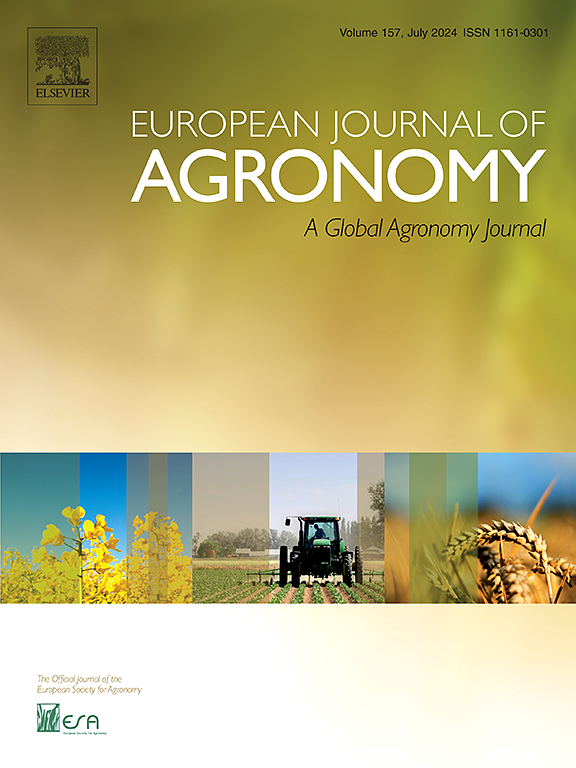基于多任务学习和多源数据的冬小麦生长指标预测
IF 5.5
1区 农林科学
Q1 AGRONOMY
引用次数: 0
摘要
及时准确地预测小麦生长指标对提高产量和减轻极端天气影响至关重要。利用多任务学习结合多源信息对生长指标进行有效监测的研究仍然有限。此外,还应注重针对生长阶段的预测,揭示生长阶段对指标的影响。本研究旨在基于光谱、水分、气象等多源、多时间特征,利用机器学习、深度学习和多任务学习对冬小麦不同生长阶段的生长指标进行预测,以评估和提高预测的准确性。对田间采集的叶面积指数(LAI)、叶绿素(CHL)、植物氮积累(PNA)、植物干物质(PDM)、植物氮含量(PNC)、氮营养指数(NNI)等生长指标进行分析,并基于Pearson相关系数(PCCfs)进行特征选择。使用随机森林(RF)、长短期记忆(LSTM)和多任务学习(MTL)开发模型,并考虑特征对指标的贡献。结果表明,RF模型的平均R²值为0.54 ~ 0.92,优于LSTM模型的平均R²值为0.08 ~ 0.88。MTL提高了模型的速度和准确性,特别是在大型数据集或深度学习应用程序中。各指标在拔节期LAI和开花期PDM表现最佳。植被指数(VI)是生长指标中最显著的特征,其次是冠层等效水厚(CEWT)和气象特征。本研究为冬小麦生长指标预测提供了一种新的方法,显著提高了预测精度,有助于实现田间精准管理。本文章由计算机程序翻译,如有差异,请以英文原文为准。
Enhancing winter wheat growth indicator prediction with multi-task learning and multi-source data
Timely and accurate prediction of wheat growth indicators is crucial for yield enhancement and extreme weather impact mitigation. Research on efficient monitoring of growth indicators using multi-task learning combined with multi-source information remains limited. Furthermore, the growth stage-specific prediction should be emphasized to reveal the effect of growth stages on the indicators. This study aims to predict winter wheat growth indicators at different growth stages using machine learning, deep learning, and multi-task learning based on multi-source and multi-temporal features, such as from spectral, moisture, and meteorological data, to evaluate and improve the accuracy of prediction. Field-collected growth indicators including leaf area index (LAI), chlorophyll (CHL), plant nitrogen accumulation (PNA), plant dry matter (PDM), plant nitrogen content (PNC), nitrogen nutrition index (NNI), and the above features were analyzed alongside feature selection based on Pearson correlation coefficients (PCCfs). Models were developed using Random Forest (RF), Long Short-Term Memory (LSTM), and Multi-Task Learning (MTL), with consideration given to the contribution of features to indicators. The results demonstrated that RF model outperformed LSTM, with average R² values ranging from 0.54 to 0.92 versus 0.08–0.88, respectively. The MTL enhanced model speed and accuracy, particularly with large datasets or deep learning applications. Each indicator exhibited optimal performance at specific growth stages, such as LAI during the jointing and PDM during the flowering. Vegetation Index (VI) emerged as the most significant features for growth indicators, followed by the canopy equivalent water thickness (CEWT) and meteorological features. This study presents a novel approach to winter wheat growth indicator prediction, significantly enhancing prediction accuracy and contributing to the achievement of precise field management.
求助全文
通过发布文献求助,成功后即可免费获取论文全文。
去求助
来源期刊

European Journal of Agronomy
农林科学-农艺学
CiteScore
8.30
自引率
7.70%
发文量
187
审稿时长
4.5 months
期刊介绍:
The European Journal of Agronomy, the official journal of the European Society for Agronomy, publishes original research papers reporting experimental and theoretical contributions to field-based agronomy and crop science. The journal will consider research at the field level for agricultural, horticultural and tree crops, that uses comprehensive and explanatory approaches. The EJA covers the following topics:
crop physiology
crop production and management including irrigation, fertilization and soil management
agroclimatology and modelling
plant-soil relationships
crop quality and post-harvest physiology
farming and cropping systems
agroecosystems and the environment
crop-weed interactions and management
organic farming
horticultural crops
papers from the European Society for Agronomy bi-annual meetings
In determining the suitability of submitted articles for publication, particular scrutiny is placed on the degree of novelty and significance of the research and the extent to which it adds to existing knowledge in agronomy.
 求助内容:
求助内容: 应助结果提醒方式:
应助结果提醒方式:


